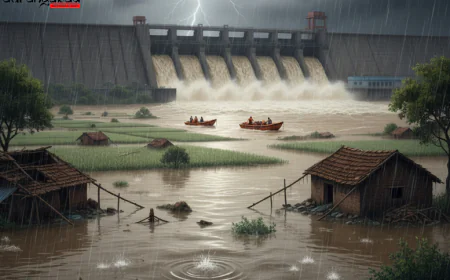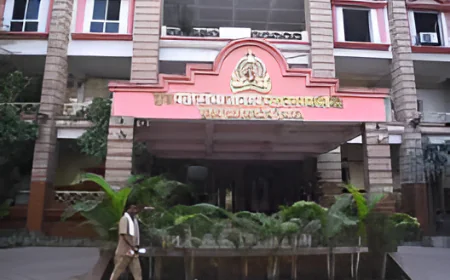Earthquake Tremors Hit Delhi
A 3.7 magnitude earthquake near Jhajjar, Haryana, caused tremors in Delhi-NCR on Friday. This followed a previous quake on Thursday, raising concerns about seismic activity in the region, which is classified under Seismic Zone IV.

NEW DELHI: The residents of Delhi and the surrounding National Capital Region (NCR) experienced palpable tension on Friday evening as significant earthquake tremors were felt across the region. This seismic event, which sent ripples through densely populated areas including Noida, Gurugram, and Faridabad, prompted an immediate public reaction, with many individuals rushing out of buildings as a precaution.
The tremors were confirmed by the National Centre for Seismology (NCS) to have measured a magnitude of 3.7 on the Richter scale. The epicenter of the earthquake was located in Jhajjar, Haryana, at a relatively shallow depth of 10 kilometers. This incident marked the second seismic event in the area within a 24-hour period, following a magnitude 4.4 earthquake on Thursday morning, raising concerns about the increasing frequency of seismic activity in the region.
Analyzing the Recent Seismic Events
The recurrence of tremors from the same localized area within a short span of time provides a critical focal point for geological experts. While both earthquakes were of moderate intensity, their shallow epicenters—just 10 km deep—mean that the seismic waves had less distance to travel before impacting the surface. This typically results in more pronounced shaking in the immediate vicinity of the epicenter and the surrounding areas, including the Delhi-NCR region.
The Thursday earthquake, which was slightly stronger at magnitude 4.4, occurred at 9:04 AM IST. The proximity of both epicenters suggests that the tremors may be linked to ongoing stress accumulation along local fault lines in the Jhajjar region of Haryana. This type of seismic activity, driven by localized geological factors, is distinct from the larger, more powerful earthquakes that originate from the major tectonic plate movements in the Himalayan arc, although both pose threats to the stability of the Delhi region.
Public Response and Safety Protocols
The immediate aftermath of the earthquake saw widespread apprehension and caution among the public. Reports from various parts of Delhi and the NCR indicated that people working in offices and residing in multi-storey apartments felt strong jolts, leading many to evacuate buildings swiftly. While no major damage to infrastructure or loss of life was reported, the incident served as a powerful reminder of the importance of maintaining public safety protocols.
Authorities and disaster management agencies, including the National Disaster Response Force (NDRF), have reiterated the importance of adopting standard safety measures during an earthquake. Experts advise residents to adhere to the 'Drop, Cover, and Hold On' protocol: immediately drop to the floor, take cover under a sturdy piece of furniture, and hold on until the shaking stops. Public awareness regarding emergency evacuation procedures and avoiding the use of elevators during tremors remains crucial in high-density urban areas.
Delhi-NCR: A Region in Seismic Zone IV
The repeated seismic events highlight Delhi's inherent vulnerability to earthquakes. The region is categorized under Seismic Zone IV, as per the zoning map released by the Bureau of Indian Standards (BIS). This classification signifies a "High Damage Risk Zone," implying that Delhi has a high probability of experiencing significant earthquakes.
Delhi's location on the Aravalli-Delhi Fold Belt and its proximity to active fault lines—such as the Delhi-Haridwar ridge, the Delhi-Moradabad fault, and the Mahendragarh-Dehradun fault—makes it highly susceptible to seismic activity. Furthermore, the region is also impacted by seismic events originating in the Himalayas, where the Indian and Eurasian plates are constantly colliding, generating tremendous seismic energy.
The threat to Delhi is amplified by its urban structure. The rapid and often unplanned development, coupled with a significant number of buildings that may not adhere to rigorous seismic-resistant standards, increases the risk of structural damage in the event of a major earthquake.
The Need for Comprehensive Preparedness
The recent tremors, while relatively minor, serve as a timely wake-up call for authorities and residents alike. The continuous monitoring of seismic activity by agencies like the NCS is vital for providing early warnings and understanding geological shifts. However, effective preparedness relies heavily on implementing and enforcing stringent building codes.
For a region in Seismic Zone IV, ensuring that all new construction adheres to anti-seismic standards is paramount. Additionally, retrofitting older buildings to withstand potential tremors is a crucial long-term strategy for disaster mitigation.
Furthermore, community-level preparedness and educational initiatives are essential. Residents must be aware of evacuation routes, safe zones within their homes and workplaces, and the necessary supplies to have on hand in case of an emergency. Regular earthquake drills and the development of local disaster response plans can significantly enhance the community's resilience to seismic events.
The tremors felt across Delhi and the NCR on Thursday and Friday underscore the persistent seismic threat faced by the capital region. While the immediate impact was minimal, these events serve as a powerful reminder of the need for sustained vigilance and proactive measures. Given Delhi's classification as a high-risk zone and its rapidly expanding infrastructure, a comprehensive and integrated approach to earthquake preparedness is not just recommended, but essential for ensuring the safety and security of its inhabitants.









































